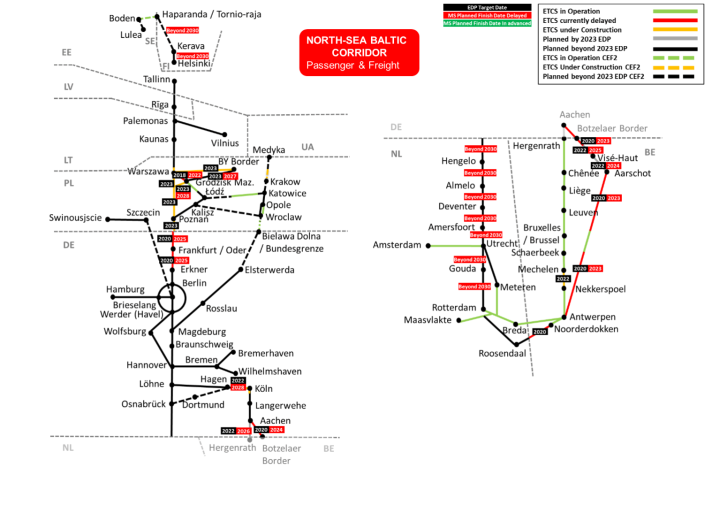Corridor description
The total length of the North Sea - Baltic corridor (NSB) is 9 030 km long, including the Connecting Europe Facility 2 (CEF 2) extension. It crosses 9 countries: the Netherlands, Belgium, Germany, Poland, Lithuania, Latvia, Estonia, Finland and Sweden.
The NSB CNC connects the ports of the Eastern shore of the Baltic Sea with the ports of the North Sea. The CEF 2 extension adds the northern Swedish port of Lulea to the corridor. From there, it passes south through the modern harbours on the Gulf of Finland of Helsinki (Vuosaari) and Tallinn (Muuga). Then continuing south through the three Baltic States and north-eastern Poland until Warsaw. CEF 2 adds a connection to the southern industrial region of Poland, passing through Krakow, Katowice and Wroclaw. From Warsaw, it follows the traditional East-West corridor to Lodz, Poznan and Berlin continuing to the ports on the North Sea coast. The corridor has branches to Ventspils in Latvia, and Klaipeda and Vilnius in Lithuania. It should be noted that sections in Latvia, Lithuania and Estonia with a track gauge that is different from the European standard nominal track gauge (i.e., sections outside the Rail Baltic) are exempt from the obligation to deploy ERTMS under TEN-T Regulation.
A key rail project is "Rail Baltica", a European standard gauge railway connecting the Baltic states to the European railway network. The project involves the construction of a new railway line spanning over 870 km from Tallinn to Warsaw, passing through Riga and Vilnius.
ERTMS deployment on the corridor
The following image shows the state of play and deadlines for the ERTMS deployment in the NSB corridor, considering the dates of the EDP:
Overall, ETCS is in operation on 12% of NSB, while GSM-R is in operation on 58% of the corridor. According to the EDP, 1 776 km are expected to be operational by 2023. In March 2023, 33% of the NSB length planned in the EDP by 2023 was in operation with ETCS. According to the TEN-T Guidelines, 7 870 km are expected to be equipped by 2030.
The deployment status per Member State where the NSB corridor runs is as follows:
- In Sweden, there are two sections of the NSB corridor. One is already operational, and the other is expected to be commissioned by 2027.
- The NSB sections in Finland will be equipped beyond 2030 (from 2030 to 2036).
- The Rail Baltica, which will connect Estonia with Poland through Latvia and Lithuania, will be operational by 2030 according to the official plan. Sections in Latvia, Lithuania and Estonia with a track gauge different from the European standard nominal track gauge (i.e. sections outside the Rail Baltica) are exempt from the deployment of ERTMS.
- Polish authorities have reported delays on some sections planned in the EDP by 2023. According to the Polish plan, all NSB sections are expected to be commissioned by 2030 except for the planned high-speed lines between Poznan/Wroclaw – Kalisz – Łódź – Opoczno / Mszczonow, for which there are no specific deadlines for NSB sections in the Polish plan.
- The lines currently in operation in the Netherlands had been already commissioned when the EDP was published in 2017. According to the Dutch plans, most of the remaining NSB Dutch sections (i.e., Rotterdam – Utrecht – Hengelo – German border line) are expected to be operational beyond 2030.
- According to the German plans, German sections planned in the EDP by 2023 will be delayed, and their commissioning is expected between 2024 and 2029. The Köln node has no planned date in the last German plan. All the German network is expected to be equipped by 2040.
- In Belgium, most of the NSB sections are already operational, including one cross-border section with the Netherlands and another one with Germany. Although some sections planned in the EDP by 2023 will be delayed, the Belgian authorities still plan the entire Belgian network to be equipped by 2025.

